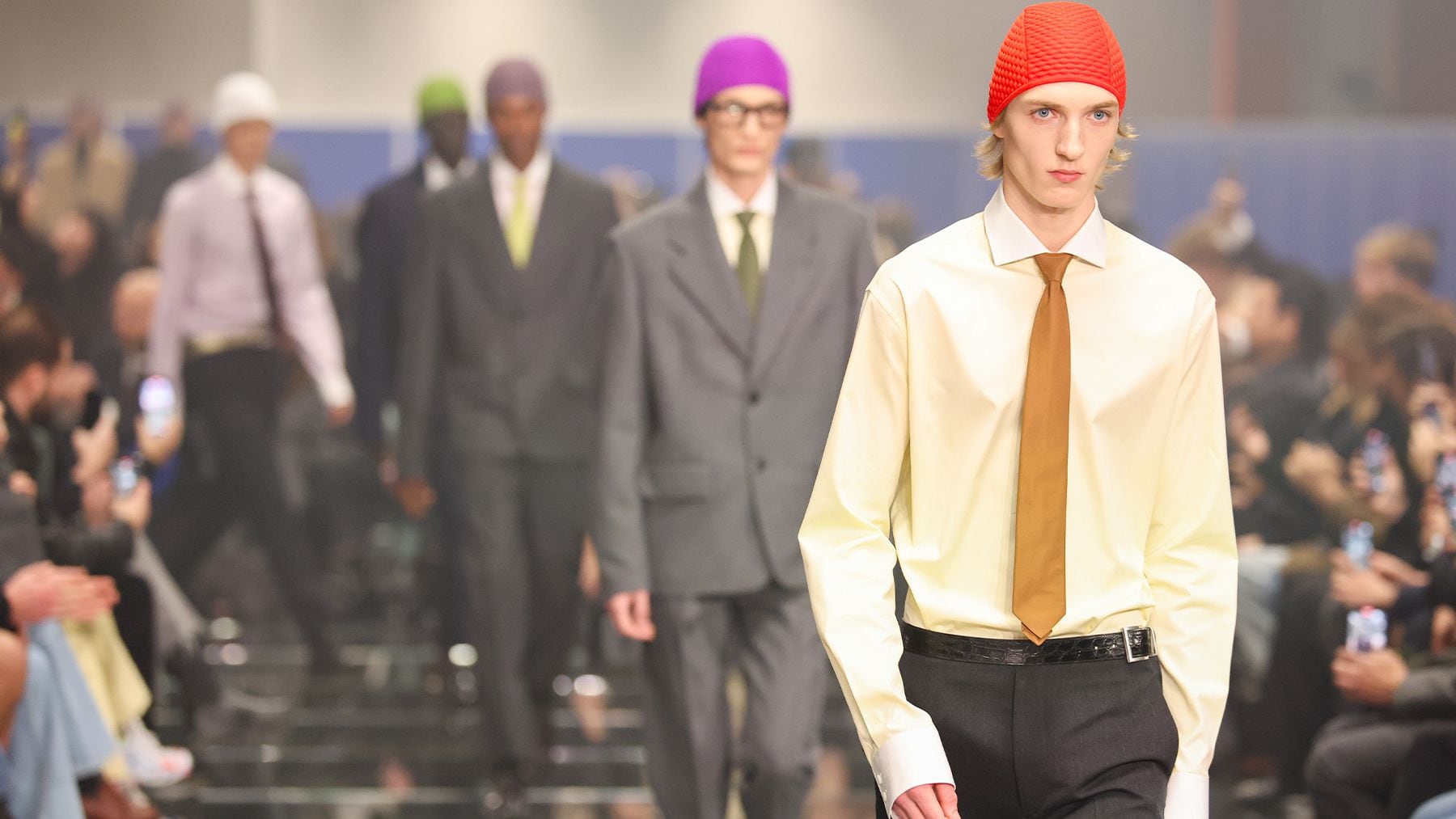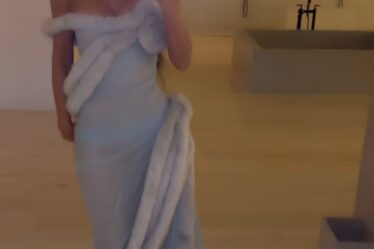
MILAN — How many ways can one say classic? Not many. In fashion terms, classicism is largely associated with formality and the vetements it requires, which are mostly sartorial and have remained unchanged for more than a century. For this reason, the classics can also read as typical, as well as time-honoured.
This is probably the reason why the very classic fashion week that closed in Milan on Monday looked at once reassuring and oh so predictable. Amid turbulent times — didn’t they say hard times give rise to wild creativity? — fashion is shifting towards the known and, at best, the elegant. This meant a resurgence of tailoring, a restoration of sorts after a period of relative lack of restraint.
At runway leader Prada, the long neglected necktie, a symbol of conformism whose death has (falsely) been predicted again and again, made a noteworthy comeback as the accessory du moment, along with slightly misplaced, Prada-esque swimming caps.
Likely following the same line of thought behind the “Everybody Talks About the Weather” exhibition staged last year at the Fondazione Prada in Venice, co-designers Mrs Prada and Raf Simons explored the collision of clothing and seasons, humanity and nature. But, as always, they did it their own way: this time, the execution twisted things up while sticking to a certain sober properness.
The show was held on a highly-Instagrammable, glass-floored set that featured Prada-branded cubicles appearing to float above moss, pebbles, leaves and a stream of water: the man-made versus nature. In such a situation, the swim-capped posse of Prada employees, feet shod in super flat lace-ups, and occasionally slippers and sandals that made them look very connected to the ground, appeared to be decked out for both business and leisure, ready for everything in their stovepipe trench coats, wonky proportioned suiting, Canadian tuxedos and sweeping topcoats.
Ultimately, the collection was straightforward, presented with a few too many styling tricks, but absolutely on point. Prada’s one-time ability to change the fashion tide was missing, however. Where one previously relied on Prada to shake up (or at least twist) the status quo, now the label is more likely to simply deliver a better version of the status quo. But that’s probably a sign of the times beyond the brand.
Jonathan Anderson is certainly an auteur, and he opted, too, for straightforwardness and a sort of deranged classicism with his latest JW Anderson collection, which was shown in the dark and featured the paintings of Christiane Kubrick, the late Stanley Kubrick’s wife, as prints. Inspired by the interiors in “Eyes Wide Shut,” the outing was a perverted foray into warped domesticity, complete with padded cardigans and bloomers resembling sofa cushions and curtains, overproportioned blazers, chinos and blousons, and sheer low-crotched pantyhose as legwear of choice. Although flawless in execution, the effort lacked Anderson’s characteristic bluntness. The women’s looks shone bright, but as a style exercise the menswear looked in need of a twist.
A strong twist is what is needed at Gucci, too, where new designer Sabato De Sarno is still in the process of identifying what his own take on the brand is all about. Inevitably, what we are seeing at the moment is a reaction to the maximalist decadence of predecessor Alessandro Michele’s tenure. Much quieter in outlook and stylistic leanings, De Sarno is the purveyor of a sort of heightened normality, which is perhaps a well-timed proposition. What his voice presently lacks, however, is the kind of boldness that can turn the simply normal into something noteworthy.
De Sarno’s first menswear show was fine but forgettable, and probably the idea of “mirroring” his September women’s show, from the colour palette to the soundtrack, was not a winner. There were too many echoes of Valentino and Prada, which is understandable as De Sarno has worked at both labels, but also avoidable. This is Gucci, after all: a brand that has to lead fashion, not to follow it.
At Dolce & Gabbana, the goings got very sleek — much in the vein of what Anthony Vaccarello started last year at Saint Laurent — and Stefano Gabbana and Domenico Dolce’s mostly black collection felt pure and accomplished.
Neil Barrett is a master minimalist, endlessly working on details and fabrications in order to create his own contemporary version of the classics. This season he was in top form: devising a sort of generational meeting — a young grandson inheriting grandpa’s stylish wardrobe and making it his own — Barrett delivered a line up of rethought staples, from the camel coat to the T-shirt, that were near perfect.
The tailoring at Brioni is always exquisitely light and effortless. Under the assured direction of Norbert Stumfl, the brand has become an epitome of ultra-luxe subtlety and sartorial gentleness, and it’s a joy to see it slowly evolve season after season.
Subtlety has always been the name of the game at Giorgio Armani, the inveterate master of soft tailoring. On the verge of turning 90 years old, with the house fast approaching its 50th year in business, Armani is, at once, fiercely averse to change and all for it. From collection to collection, the core codes stay as they are — no need to change them — but proportions evolve, slightly yet relentlessly.
This season, for instance, everything got slouchier, roomier and softer, with the brand’s trademark ease and a mild formality. Volumes were oversized at Emporio Armani, where the tailoring, for proper contrast, was not slouchy but bold and affirmative, which made for a noteworthy collection inspired by the sea in the winter. True to Armani spirit, a lot of the men’s look were proportioned to women’s sizes, and this felt strong.
Tailoring was so pervasively present in Milano this season that it reached even the edgy shores of Jordanluca, where it looked sharp and punky, in a collection that was quite gloomy in appearance but light in spirit. If that doesn’t quite make sense, it’s because contrasts are the magic of the brand, which has taken recent strides.
The MSGM show opened with a long tailored black coat emblazoned with a red sign in the shape of the iconic handrail devised by architect Franco Albini for the red line of Milan’s subway. The show actually took place in the mezzanine of the Porta Venezia station, which was the city’s first underground station to be opened in 1964. The theme seemed to be fast life in the big city, and it was apt and timely. But the goings soon veered off in other directions, as often happens with creative director Massimo Giorgetti, and there was way too much sparkle à la Miu Miu and odd masculinity à la JW Anderson, which was a shame. Giorgetti is best when he stays focused.
Tailoring does not always mean tradition. Setchu’s Satoshi Kuwata matches the cutting prowess of his Savile Row training with a fiercely deconstructivist mind, and the result is impressive: formal/informal clothing that can be zipped and unzipped, tied and untied, and ultimately worn in multiple ways. This season textures came to the fore together with cuts, and there was a newfound sense of playfulness that felt timely.
The drag extravaganza at the end of the DSquared2 show, by comparison, felt like an unneeded cliché that added very little to an interestingly double-sided collection that juxtaposed the sleazy and dirty with the polished, glamorous and tailored.
Among the noteworthy upstarts and newcomers were Federico Cina, whose unique brand of streamlined melancholia gets more mature season after season, and Domenico Orefice, whose take on the dark industrial aesthetic feels intensely personal.
Also worth mentioning are Institution, the radical new project, made with deadstock fabric and shoelaces, from Act N.1′s founder Galib Gassanov, and upcycling brand Simon Cracker, whose messy and dreamy style populated the only Milan show with a wide range of body types on the catwalk.
Of course, none of these up and comers can compete with Moncler-scale budgets, which allowed Stone Island, the cult sportswear brand the group acquired in 2020, to go big with its first ever fashion week event. The results were too Moncler-esque, however, with a grandiose visual language that felt too loud for a brand so firmly rooted in its own niche; wide and transversal, for sure, but still a niche.
In a season of utter classicism, perhaps the biggest winners were Silvia Venturini Fendi and Alessandro Sartori, who worked the notion of classics with stylistically seditious minds. At Fendi, a basic hunting and countryside theme was brought to new heights with references to Britain’s Anne Princess Royal. This made for a palpable yet playful tension of the masculine and the feminine which gave relatively straightforward items fresh energy. Venturini Fendi has quite a unique language: her expression is at once vibrant and dry, and so is the singular man she envisions.
Over at Zegna, Alessandro Sartori keeps being a master perfectionist and a reductionist. His work is extremely classic in the sense that it is rooted in tailoring, but the way he lets these roots flourish is fiercely modern, streamlined and pure. Made almost exclusively in cashmere, which was brought this way and that, the collection was Sartori’s most accomplished since Zegna’s reset. It looked at once very human and very sci-fi, with a winning sense of multi-purposeness and modularity, opening up the idea of classico to something a little less predictable than a suit and tie.



